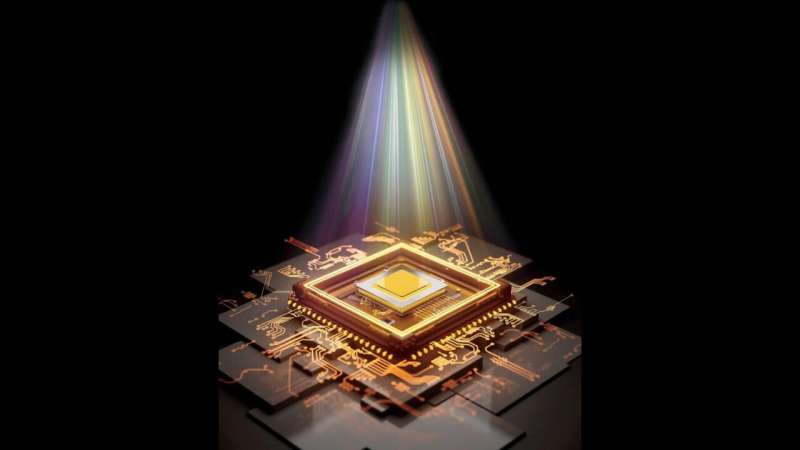November 1, 2023 feature
This article has been reviewed according to Science X's editorial process and policies. Editors have highlighted the following attributes while ensuring the content's credibility:
fact-checked
peer-reviewed publication
trusted source
proofread
The future of AI hardware: Scientists unveil all-analog photoelectronic chip

Researchers from Tsinghua University, China, have developed an all-analog photoelectronic chip that combines optical and electronic computing to achieve ultrafast and highly energy-efficient computer vision processing, surpassing digital processors.
Computer vision is an ever-evolving field of artificial intelligence focused on enabling machines to interpret and understand visual information from the world, similar to how humans perceive and process images and videos.
It involves tasks such as image recognition, object detection, and scene understanding. This is done by converting analog signals from the environment into digital signals for processing by neural networks, enabling machines to make sense of visual information. However, this analog-to-digital conversion consumes significant time and energy, limiting the speed and efficiency of practical neural network implementations.
The proposed all-analog photoelectronic chip, as detailed in the research, addresses this limitation by combining photonic and electronic computing in a single chip, offering a groundbreaking solution for high-speed and energy-efficient visual data processing. The findings of the study are published in Nature, along with a Research Briefing summarizing the work.
Dr. Jiamin Wu, one of the authors of the study, explained to Phys.org why they focused on the hardware side of things, saying, "Our team, motivated by enhancing the real-world impact of AI advancements, has long been dedicated to developing efficient hardware solutions for AI execution."
Best of both worlds
Combining optical and electronic analog computing modules in the study is a pivotal aspect as it allows the researchers to harness the benefits of both light (in the form of photons) and electrons in an all-analog manner.
In doing so, the researchers have addressed the practical limitations of photonic (light-based) computing, such as the complicated implementation of optical nonlinearity, considerable power consumption of ADCs, and vulnerability to noises and system errors.
"An optical computing module that implements a diffractive neural network is first used to extract information and reduce data dimensionality in a highly parallel way," explained Dr. Wu. This process is highly efficient and allows information to be extracted from high-resolution light fields.
"The output of the optical computing module is then received by a photodiode array to generate light-induced photocurrents. These are directly used for further computation in the electronic analog domain," he continued. This seamless conversion allows for the creation of intricate network structures, enhancing overall task performance.
The module further analyzes the light-generated electric currents. Notably, it doesn't require converting analog signals into digital ones. This flexibility in electronic circuits enables adaptive and reconfigurable training methods, which are essential for real-world performance improvements.
The researchers were able to successfully design an integrated photoelectronic processor called an "all-analog chip combining electronic and light computing," or ACCEL.
"By utilizing the intrinsic nonlinearity of photoelectric effect and data processing in the analog electronic field without analog-to-digital conversion, the proposed all-analog photoelectronic chip achieves energy efficiency and computing speed that are several orders of magnitude higher than those of state-of-the-art digital processor," said Dr. Wu.
Putting it to the test
The researchers conducted a series of tests to test the ACCEL's classification accuracies in various tasks, including recognizing handwritten numbers, distinguishing clothing items, and interpreting cursive writing.
It displayed the ability to classify high-resolution images within 72 nanoseconds, a feat that defies the limits of conventional processing. Astonishingly, the ACCEL consumes 4 million times less energy than a top-of-the-line GPU, even though it is more than 3,000 times faster.
But the ACCEL chip doesn't stop there. Its adaptability extends to incoherent light sources, making it a versatile solution with applications beyond the expected.
"Compared to high-performance GPUs, our all-analog photoelectronic chip is three orders of magnitude faster and six orders of magnitude more energy-efficient. This makes it suitable for high-speed processing in applications like industrial assembly lines and autonomous driving."
"Moreover, thanks to its exceptional computing efficiency and minimal energy demands, our chip could bring a new era for portable systems such as wearable devices for health monitoring, where the system is traditionally powered by a battery and the life-span of the device has been severely constrained due to the limited energy source," said Dr. Wu.
Future work
The researchers acknowledge that while the all-analog photoelectronic demonstrated high power and efficiency, there's still room for improvement.
"Though the ACCEL achieved fast computing speed and high energy efficiency, there is still room for the improvement of the processing capability of this chip," explained Dr. Wu.
In the future, the researchers hope to explore more efficient architectures with photoelectronic computing to handle more extensive computer vision tasks and extend this technology to new artificial intelligence algorithms like large language models (LLMs).
This ongoing research aims to push the boundaries of analog photonic technology for future advancements.
More information: Yitong Chen et al, All-analog photoelectronic chip for high-speed vision tasks, Nature (2023). DOI: 10.1038/s41586-023-06558-8
Computer vision accelerated using photons and electrons, Nature (2023). DOI: 10.1038/d41586-023-02947-1
© 2023 Science X Network



















